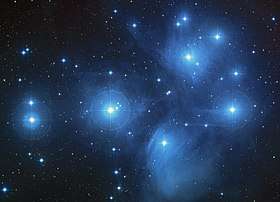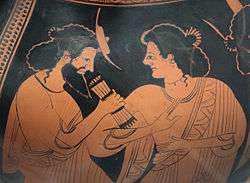Maia (star)
 | |
| Observation data Epoch J2000 Equinox J2000 | |
|---|---|
| Constellation | Taurus |
| Right ascension | 03h 45m 49.6067s[1] |
| Declination | 24° 22′ 03.895″[1] |
| Apparent magnitude (V) | 3.871[1] |
| Characteristics | |
| Spectral type | B8III[1] |
| U−B color index | -0.40 |
| B−V color index | -0.07[2] |
| Variable type | Suspected |
| Astrometry | |
| Radial velocity (Rv) | 7.5[1] km/s |
| Proper motion (μ) | RA: 21.09[1] mas/yr Dec.: -45.03[1] mas/yr |
| Parallax (π) | 8.2 ± 1.03[3] mas |
| Distance | approx. 400 ly (approx. 120 pc) |
| Absolute magnitude (MV) | -1.69 |
| Details | |
| Mass | 5+[4] M☉ |
| Radius | 6.04[4] R☉ |
| Luminosity | 850[4] L☉ |
| Temperature | 12,600[4] K |
| Metallicity | 1.10 Fe/H[5] |
| Rotation | 33 km/s[6] |
| Other designations | |
| Database references | |
| SIMBAD | data |
Coordinates: ![]()
Maia, designated 20 Tauri (abbreviated 20 Tau), is a star in the constellation of Taurus. It is the fourth-brightest star in the Pleiades open star cluster (M45), after Alcyone, Atlas and Electra, in that order. Maia is a blue giant of spectral type B8 III, and a mercury-manganese star.
Maia's visual magnitude is 3.871, requiring darker skies to be seen. Its total bolometric luminosity is 660 times solar, mostly in the ultraviolet, thus suggesting a radius that is 5.5 times that of the Sun and a mass that is slightly more than 4 times solar.[4] It was thought to be a variable star by astronomer Otto Struve. A class of stars known as Maia variables was proposed, which included Gamma Ursae Minoris, but Maia and some others in the class have since been found to be stable.[4]
Maia is one of the stars in the Maia Nebula (also known as NGC 1432), a bright emission or reflection nebula[7] within the Pleiades star cluster.
Nomenclature
20 Tauri is the star's Flamsteed designation. The name Maia originates with the Greek: Μαῖα and Latin: Maia. She is one of the seven daughters of Atlas and Pleione in Greek mythology—stars which are also included in the Pleiades star cluster (see map).

Maia was the oldest of seven beautiful sisters known as the Pleiades. She was impregnated by Zeus, thereby conceiving Hermes, the messenger god. As Maia and the Pleiades are visible in the winter night sky along with the constellation Orion, the Greek myths tell of Maia and her sisters being pursued by the giant huntsman, and turned into doves to preserve their safety.[8]
In 2016, the International Astronomical Union organized a Working Group on Star Names (WGSN)[9] to catalog and standardize proper names for stars. The WGSN's first bulletin of July 2016[10] included a table of the first two batches of names approved by the WGSN; which included Maia for this star. It is now so entered in the IAU Catalog of Star Names.[11]
See also
- Lists of stars in the constellation Taurus
- Class B Stars
- Mercury-manganese star
- Maia in fiction
References
- 1 2 3 4 5 6 7 "* 20 Tau". SIMBAD. Centre de données astronomiques de Strasbourg. Retrieved 2010-06-11.
- ↑ Johnson, H. L.; Iriarte, B.; Mitchell, R. I.; Wisniewski, W. Z. (1966). "UBVRIJKL photometry of the bright stars". Comm. Lunar Plan. Lab., 4. SIMBAD. Bibcode:1966CoLPL...4...99J.
- ↑ Perryman, M. A. C.; et al. (1997), "The Hipparcos Catalogue", Astronomy & Astrophysics, 323: L49–L52, Bibcode:1997A&A...323L..49P
- 1 2 3 4 5 6 Professor James B. (Jim) Kaler. "MAIA (20 Tauri)". University of Illinois. Retrieved 2010-06-11.
- ↑ Heacox, W. D. (1979). "Chemical abundances in Hg-Mn stars". Astrophysical Journal Supplement Series. 41: 675–688. Bibcode:1979ApJS...41..675H. doi:10.1086/190637.
- ↑ Royer, F.; Grenier, S.; Baylac, M.-O.; Gómez, A. E.; Zorec, J. (2002). "Rotational velocities of A-type stars in the northern hemisphere. II. Measurement of v sin i in the northern hemisphere". Astronomy and Astrophysics. 393 (3): 897–911. arXiv:astro-ph/0205255. Bibcode:2002A&A...393..897R. doi:10.1051/0004-6361:20020943.
- ↑ "SEDS Students for the Exploration and Development of Space". NGC 1432. Retrieved 2010-06-11.
- ↑ Hesiod, Works and Days 619ff.
- ↑ "IAU Working Group on Star Names (WGSN)". Retrieved 22 May 2016.
- ↑ "Bulletin of the IAU Working Group on Star Names, No. 1" (PDF). Retrieved 28 July 2016.
- ↑ "IAU Catalog of Star Names". Retrieved 28 July 2016.
External links
| Wikimedia Commons has media related to Maia (star). |
- Jim Kaler's Stars, University of Illinois:Maia (20 Tauri)
- High-resolution LRGB image based on 4 hrs total exposure: NGC 1432 - Maia Nebula
- APOD Pictures: